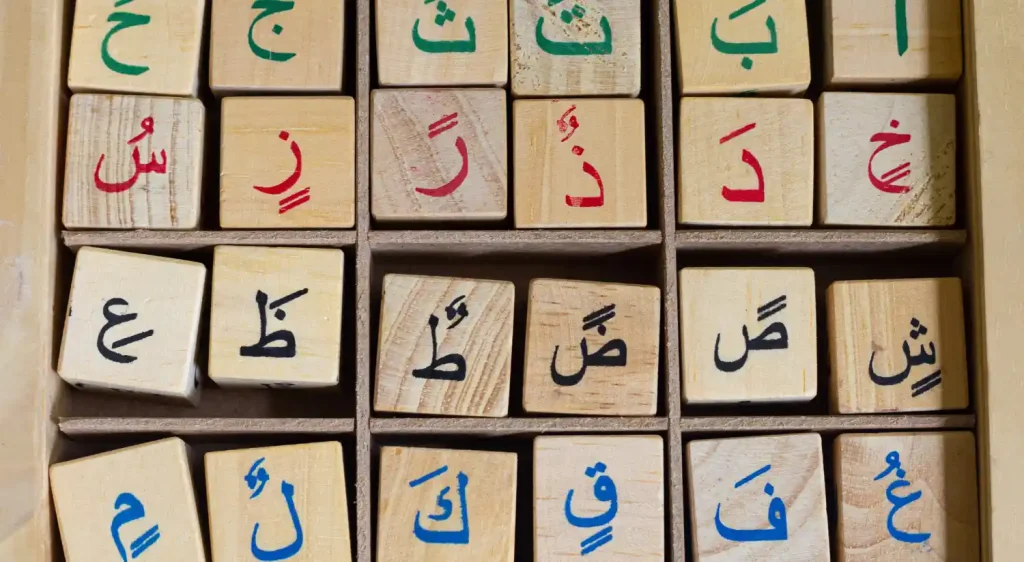
Arabic writing is one of the oldest and most beautiful forms of communication in the world. With its fluency, elegance and complexity, learning to write in Arabic can be a fascinating and enriching experience.
In this guide, we will explore the secrets of the Arabic script, giving beginners the tools they need to start their journey in learning this wonderful language.
The Arabic Writing
History and origin of the Arabic script
The Arabic script has its roots in the Arabian Peninsula, with a history dating back more than a thousand years before Christ.
It is believed to have originated from the semi nomadic Nabataean tribes and Aramaic scripts. With the spread of Islam in the 7th century, Arabic became the liturgical and administrative language of much of the Islamic world, which helped spread and standardize the Arabic script.
Main characteristics of Arabic script
The Arabic writing is characterized by several peculiarities that greatly distinguish it from other writing systems:
- Writing direction: Arabic is written and read from right to left.
- Letter connection: Arabic letters connect to each other within words, resulting in a flowing, cursive script.
- Letter shapes: Each letter has up to four different shapes, depending on its position in the word (initial, middle, final or isolated).
- Absence of short vowels: Short vowels are generally not written in Arabic texts, although diacritical marks can be added to indicate pronunciation.

The arabic alphabet
The 28 letters of the Arabic alphabet
The Arabic alphabet consists of 28 letters, each with its own unique shape and sound.
Here is a list of the letters with their approximate names and sounds in English:
Arabic Alphabet Chart
| Letter | Name | Approximate Sound |
|---|---|---|
| ا | Alif | a (like in “apple”) |
| ب | Ba | b (like in “boat”) |
| ت | Ta | t (like in “tomato”) |
| ث | Tha | th (like in “thin”) |
| ج | Jim | j (like in “jeep”) |
| ح | Ha | h (guttural sound) |
| خ | Kha | kh (deeper guttural sound, like the Spanish “J” <jota>) |
| د | Dal | d (like in “Dad”) |
| ذ | Dhal | dh (like in “this”) |
| ر | Ra | r (a trite R) |
| ز | Zay | z (similar to “thin” but stronger) |
| س | Sin | s (like in “house”) |
| ش | Shin | sh (like in “sheep”) |
| ص | Sad | s (emphatic, like in “soil” ) |
| ض | Dad | d (emphatic) |
| ط | Ta | t (emphatic) |
| ظ | Za | z (emphatic) |
| ع | Ayn | ʿ (light guttural sound) |
| غ | Ghayn | gh (guttural sound) |
| ف | Fa | ph (like in “Pharmacy”) |
| ق | Qaf | q (guttural sound) |
| ك | Kaf | k (like in “kilo”) |
| ل | Lam | l (like in “lamb”) |
| م | Mim | m (like in “mother”) |
| ن | Nun | n (like in “new”) |
| ه | Ha | h (like in “here”) |
| و | Waw | w/u (like in “way”) |
| ي | Ya | y/i (like in “yes”) |
Letters Shape
Each Arabic letter has a different shape depending on its position inside the word:
- Isolated: when the letter is not connected to any other letter.
- Initial: When it is the word’s first letter.
- Middle: When the letter is in the middle of the word.
- Final: When it is the word’s last letter.
For example, the letter “Ba” (ب) has the following writings:
- ب (isolated)
- بـ (initial)
- ـبـ (middle)
- ـب (final)

Pronunciation and phonetics
Vowels and diacritical marks
Although short vowels are not normally written in Arabic texts, it is important to know them for correct pronunciation:
- َ (fatha) – short a
- ِ (kasra) – short i
- ُ (damma) – short u
There are also diacritical marks such as:
- ْ (sukun) – indicates the absence of a vowel
- ّ (shadda) – indicates the consonant sound being doubled
Emphatic and guttural consonants
Arabic has several sounds that do not exist in English, such as emphatic and guttural consonants.
Emphatic consonants (ص, ض, ط, ظ) are pronounced with greater constriction in the throat, while guttural consonants (ح, خ, ع, غ) are produced in the back of the mouth.
Pronunciation exercises
To improve our pronunciation in Arabic, it is useful to practice with specific exercises.
Here are some examples
- Emphatic consonants: practice repeating words containing emphatic consonants, such as “صباح” (sabah, tomorrow) and “ظلال” (thilal, shadows).
These sounds require precise control of the throat and tongue, so it is essential to repeat them frequently.
- Gutturals: Try pronouncing words with guttural sounds, such as “غابة” (ghaba, forest) and “عين” (ayn, eye).
These sounds are produced in the back of the mouth, which can be challenging at first, but with practice, it becomes more natural.
- Short and long vowels: differentiate between short and long vowels with words like “كتاب” (kitab, libro) y “كاتب” (katib, escritor).
Practicing the correct pronunciation of these vowels helps avoid misunderstandings and improves fluency.
- Simulated Conversations: Participate in simulated conversations in Arabic, either with a study partner or using language learning tools. This will allow you to practice in a realistic context and improve your ability to respond.
Constant practice and repetition are key to mastering Arabic pronunciation. Don’t be discouraged if you find it difficult at first; with time and dedication, you will notice a significant improvement in your ability to pronounce correctly.
Basic Grammar
Nouns and gender
In Arabic, nouns have gender (masculine or feminine) and number (singular, dual and plural). Generally, feminine nouns end in “ة” (ta marbuta).
For example:
- كتاب (kitab, book) – masculine
- مدرسة (madrasa, school) – feminine
Adjectives and agreement
Adjectives in Arabic agree in gender and number with the nouns they describe.
For example:
- كتاب كبير (kitab kabir, big book) – masculine singular.
- مدرسة كبيرة (madrasa kabira, large school) – feminine singular.
- كتب كبيرة (kutub kabira, big books) – feminine plural (feminine plural; adjectives often have the same form as singular).
Verbs and conjugations
Arabic verbs are conjugated according to tense (present, past, future), gender and number.
Here is an example of conjugation of the verb “to write” (كتب – kataba):
- I write: أكتب (aktubu)
- You write (m): تكتب (taktubu)
- You write (f): تكتبين (taktubina)
- He writes: يكتب (yaktubu)
- She writes: تكتب (taktubu)
- We write: نكتب (naktubu)
Writing practice

Techniques to improve writing
Learning to write in Arabic requires constant practice.
Here are some useful techniques to make it easier for you to learn them:
- Calligraphy: Practicing Arabic calligraphy helps to improve the accuracy and beauty of handwriting. There are different styles of calligraphy, such as naskh and ruqʿah, that can be learned to improve fluency.
- Copying Exercises: Copying Arabic texts is an excellent way to become familiar with the shape and flow of letters: Copying Arabic texts is an excellent way to become familiar with the shape and flow of letters.
- Creative Writing: Try writing simple sentences and paragraphs in Arabic on topics that interest you.
- This not only improves your writing skills, but also enriches your vocabulary.
Online resources and tools
There are numerous online resources and tools to assist you to learn Arabic script:
- Calligraphy Apps: Apps such as “Write It! Arabic” and “Learn Arabic Alphabet” offer interactive lessons for learning Arabic calligraphy.
- Language Platforms: Websites such as Duolingo and Memrise include specific modules for learning to write Arabic.
- Videos and Tutorials: YouTube has a wealth of free tutorials on Arabic writing, from basic lessons to advanced calligraphy techniques.
The benefits of learning the Arabic script
Cultural connection
Learning to write in Arabic is not only a valuable language skill, but it also allows you to connect more deeply with the rich culture and history of the countries with that language.
Arabic calligraphy is an art form in itself, and understanding it gives you a deeper appreciation for the artistic and literary traditions of the region.
Career Opportunities
Mastering Arabic writing can open many doors in the professional arena.
In a globalized world, the demand for Arabic speakers and writers is on the rise in fields such as diplomacy, international business, translation and education.
This skill can make you stand out in the job market and offer unique opportunities.
Cognitive enhancement
Learning a new writing system, especially one as complex as Arabic, also has cognitive benefits.
It stimulates the brain, improves memory and increases problem-solving skills. On top of that, the process of learning a new language and writing can improve your multitasking and critical thinking skills.
Travel and experiences
Knowing the Arabic script enriches and helps a lot in your travel experiences in Arabic speaking countries.
You will be able to read signs, menus and local literature, which will allow you to move around more easily and enjoy your stay more.
In addition, interacting with locals in their native language will give you a more authentic and rewarding perspective of their customs and way of life.
An enlightening journey
The Arabic script is a gateway to one of the oldest and most fascinating cultures in the world. Learning it can be challenging, but it is also a deeply enriching experience that will allow you to connect with millions of people and better understand their history and way of life.
From the elegant shapes of its letters to the depth of its pronunciation, every aspect of Arabic writing offers an opportunity to learn.
Whether you’re looking to improve your language skills, advance your career, or simply enjoy the beauty of a new form of communication, learning Arabic will open countless doors.
So don’t hesitate and start practicing with our tips.







Newsletter